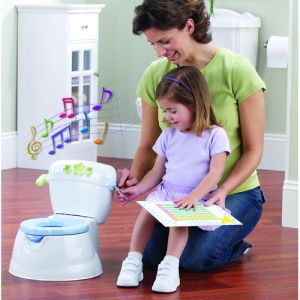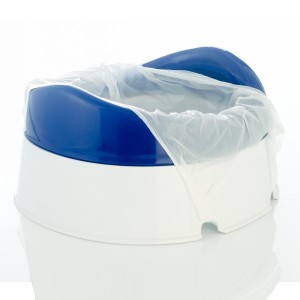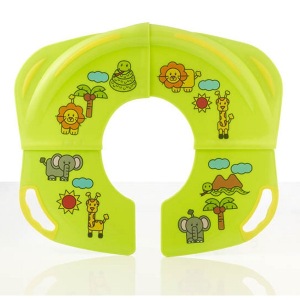Travel pottys, folding toilet seats and rewards pottys. In this blog Bunny Bumpkin gives some tips on potty training and introduces some of the great products that are available to make toilet training easier.
Potty training can be a challenging time for both mother and child.
Bunny Bumpkin has pulled together this guide from various reliable
resources on the subject to help. We have also included some products to
help with the process. Just click on the pictures for more product
information.
When to start
Every child is different and it is important not to try to force them before they are ready.
Generally speaking most children are ready to start between 18 and 24 months.
It
is always easier to start in the summer as there are less clothes to
take off when they need to go and you can let them run around in the
garden without a nappy on.(Don’t forget the sun screen)
Your child
will give you clues that they are ready such as telling you that they
have had a wee in their nappy or if you are lucky, telling you before
they want to go.
How to start
Always have a potty in sight in the main rooms the child uses.
It is good to let the child see older children and even yourself using the toilet (which you may refer to as the big potty)
Leave
the nappy off at times of the day that they usually go. (as long as
this doesn’t distress them. If it does then leave it a few more weeks
and try again)
If you see them weeing, put them on the potty even
if it is too late so they get the association. Do this with a minimum of
fuss or they may become anxious about going to the toilet.
You
will often have to clean up the mess when it doesn’t work out. Do this
without complaint but cheerfully point out that it is better to use the
potty.
Give them praise when they use the potty. Using the potty
should be a fun and rewarding experience. This Safety First rewards
potty available from Bunny Bumpkin is a great idea. It gives encouraging
phrases and songs, guides them through the steps of using the potty and
then dispenses stickers when they are successful. Avoid using sweets as
rewards.
Be
patient. It can take months to potty train a child and there will be
setbacks even when things have been going well. Don’t get angry with
them.
Prepare for travel.
Putting a nappy back on
your child when you are travelling will confuse them. Keep a travel
potty in the car .This Babyway travel potty is also available from Bunny
Bumpkin.
Graduating to the toilet
As
they get the hang of the potty it will not be long before they want to
start using the big toilet like mummy, daddy and siblings. They may ask
to do this. Using the toilet is a lot more convenient for you,
particularly with number twos.
Invest in a toilet trainer seat. This Little Wonder training seat can be used for travel also as it folds up.
Night Time
Although
most children learn night time bladder control between the ages of
three and five, it is estimated that a quarter of three-year-olds and
one in six five-year-olds wet the bed. If bedwetting persists beyond 6
or 7 then it is worth consulting the doctor to check there is no
underlying medical condition.
Encourage your child to go to toilet before going to bed.
Do
not punish the child for wetting the bed. They are unaware that they
are doing it. Making them anxious about it will just make it worse.
Bunny Bumpkin is an online retailer providing everything a mum needs for pregnancy, nursing and the childs early years. Subscribe to Bunny Bumpkins newsletter at www.bunnybumpkin.com
For more blogs about parenthood and babies click here
Sunday, 7 April 2013
Tuesday, 2 April 2013
Can I swim when pregnant?
The simple answer is yes but with some precautions. Swimming is often encouraged by midwives in the UK.
Here are some of the benefits of swimming while pregnant
What to wear when swimming?
In the first trimester of pregnancy you should be able to wear your existing swimsuits. However by the second trimester you will need to invest in a maternity swimsuit. Swimsuits like this Emma Jane Swimsuit available from www.bunnybumpkin.com have ruched sides to allow for body changes during pregnancy. There is also an elasticated bra shelf for comfort and support.
The swimsuit you buy in the second trimester should also see you through to the third.
Another option is a maternity tankini. The tankini has the advantage of not having to remove the whole swimsuit when you need to go to the toilet.
So what are you waiting for? Take the weight off your feet, cool yourself down and take a dip
For more blogs about pregnancy visit our pregnancy blog page
Here are some of the benefits of swimming while pregnant
- Swimming is a great low impact aerobic exercise that takes the weight off the joints.
- It allows you to move freely in the water which is something you may struggle to do out of the water as your pregnancy advances.
- While you are in the water your blood pressure is likely to be lower
- Swimming is great for relaxation and exercise helps you sleep better at night
- Its low risk. With land based exercises you risk hurting yourself and baby if you fall. Once you are in the water you are supported so any slip is much less risk. Be careful before getting in though.
- If you have never exercised before, start slowly, warm up and cool down gradually before getting out.
- Avoid any stroke that feels uncomfortable
- Drink plenty of water to avoid dehydration as it can get hot in indoor swimming pools
- If in doubt, check with your GP
- Swimming is ok but scuba diving isn’t because the baby has no protection against decompression sickness and gas embolism (gas bubbles in the bloodstream)
What to wear when swimming?
In the first trimester of pregnancy you should be able to wear your existing swimsuits. However by the second trimester you will need to invest in a maternity swimsuit. Swimsuits like this Emma Jane Swimsuit available from www.bunnybumpkin.com have ruched sides to allow for body changes during pregnancy. There is also an elasticated bra shelf for comfort and support.
The swimsuit you buy in the second trimester should also see you through to the third.
Another option is a maternity tankini. The tankini has the advantage of not having to remove the whole swimsuit when you need to go to the toilet.
So what are you waiting for? Take the weight off your feet, cool yourself down and take a dip
For more blogs about pregnancy visit our pregnancy blog page
Subscribe to:
Comments (Atom)




